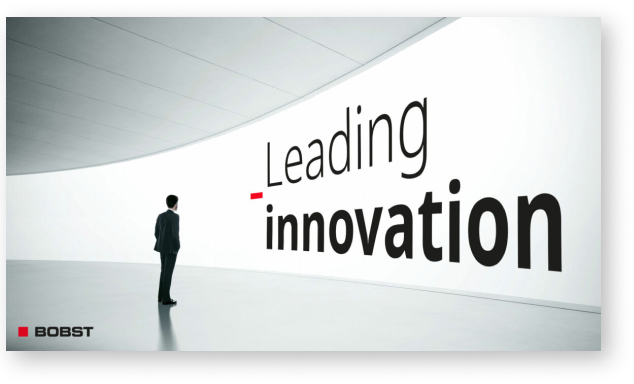B2B brands — billions of added value
How a strong brand creates
value — especially in B2B.
Every day, more than forty-five thousand new brands are created worldwide.1 The battle for perception is merciless. B2B companies are not exempt from this. Because the purchase decision for B2B products and services is taken by people who trust strong brands.
Discover our B2B Branding Guide and learn how strategic branding drives business success in B2B, creating a strong B2B brand experience.

From logo to strong brand – improve your B2B brand experience
What is a brand?
The brand is an image in the mind: it is composed of visuals, values and stories that are associated with a brand name or logo. A brand is created through perception of communication, product, services, etc.. In a well-managed brand, the positioning of the brand matches the perception of the brand.
What is a logo?
The logo represents the brand in a nutshell. It serves as a visual vessel in which we collect experiences and associate them with the brand. The image of the brand is evoked by the sight of the logo. In order to turn the logo into a strong brand, the brand must be built and communicated in a strategically targeted way.
What is B2B branding?
B2B stands for “business-to-business” – the business relationship between companies. A B2B brand is aimed at corporate customers – not at end consumers. B2B branding is the systematic development and implementation of the corporate brand to support the business success of a B2B company.
In this context, the brand is aligned to specific corporate needs in various dimensions. These dimensions include
- Clarifying the brand architecture. How many different brands are required to run the business successfully? What is the relationship between the brands? How can the brand portfolio be simplified to the max, e.g. by replacing different product brands through a systematic product nomenclature?
- Translating the corporate strategy into a brand strategy. How should the brand be positioned and perceived – highly relevant for its stakeholders, and at the same time differentiating from competitors? What does the brand stand for? Which attributes and images should be associated with the brand?
- Creating an attractive, differentiating and relevant brand experience. Which colors, imagery and designs convey the brand strategy best, ensuring that the intended positioning matches the perception? How can maximum attention and recognition be generated with limited resources?
- Consistently implementing the brand appearance. Only consistent implementation of the brand experience across all touch-points ensures success. Because that’s the only way customers, talents and other stakeholders will recognize the brand – and deeply anchor the brand in their minds.
B2B branding is the strategic and systematic development and implementation of the corporate brand
How does B2B branding differ from consumer branding?
B2B brands differ in key aspects from brands that directly address end consumers. These differences include:
- Visibility: B2B brands have a significantly reduced number of branded touch-points and thus achieve lower visibility in the market.
- Purchase decision: B2B brands are usually characterized by a more complex buying and decision-making process. In the consumer sector, buyers choose directly between brands – on the physical shelf, or in the digital store. B2B purchase decisions are based on a more complex process: the entire value chain is included in form of comprehensive solutions, e.g. from the planning of a plant or product portfolio to downstream services and ongoing subsequent updates and deliveries.
Which role does the B2B brand play in the purchase decision?
In B2B, the brand contributes between 2% and 20% to the purchase decision.2 This value is called “role of brand” and depends strongly on the industry and the positioning of the brand.
While the role of brand can be as high as 20% in innovation industries such as med-tech, the brand plays a lesser role in the commodity sector (e.g. basic chemicals), where the focus is on standardized quality and availability of the substances. Positioning also influences the role of brand: premium brands contribute significantly more to the purchase decision than low-priced entry-level brands.
A role of brand of 2% may seem low. But with sales of e.g. 100 million, 2 million are earned exclusively by the power of the brand.
Why is a strong brand important for B2B companies?
The brand is a key factor for business success, also in B2B. Because every brand contributes to the purchase decision. And purchase decisions are fundamentally made by people. In B2B as well. Trusting a brand is key – because details often can’t be verified. And complex products and services are hard to communicate easily and quickly. In this case, the brand has a trust-building effect.
Over time – and with proper brand care – the brand will develop into an important intangible asset. The world’s most valuable brands are valued at several hundred billion US dollars.
Purchase decisions are always made by
people – even in B2B.
What is the difference between B2B branding and B2B marketing?
B2B branding is the strategic and systematic alignment of the corporate brand to support the business success of a B2B company. B2B Marketing is the tactical communication to promote the products and services of a B2B company.
What are the benefits of good B2B branding?
Good B2B branding
- creates preference: it makes the brand the preferred brand.
- enables a price premium: the company can realize a higher price compared to similar competing products.
- reduces costs: through high communication efficiency and a focus on one or a few brands, a company increases its profitability.
- reduces risks: established and well-known brands find it easier to introduce new products and services.
How does a strong B2B brand reduce risks?
A strong B2B brand generates leads: the strongest competitors are top-of-mind with buyers and thus reliably in the so-called “relevant set” in a competitive evaluation.
B2B brands with a good reputation also protect their customers: choosing a renowned brand minimizes the risk of making a wrong decision. For large investments, a strong B2B brand contributes disproportionately to building trust, as studies show. Therefore, the consistent and ongoing investment in the development and maintenance of a B2B brand is worthwhile.
How do you develop a successful B2B brand?
The basis for a successful B2B brand is the clear alignment of the brand with the corporate strategy: how can the brand help to implement the strategy, for example, to achieve growth, enable internationalization or increase profitability?
Precise brand positioning ensures that corporate goals are translated into attractive communication. Positioning therefore involves defining at least three elements: Brand Idea, Brand Story and Brand Personality. Positioning must also ensure that the brand is relevant to all stakeholders – and at the same time differentiating from competitors.
The positioning is the foundation for the development of the B2B brand experience. Brand idea and brand personality are translated into visual elements (logo, imagery, colors, typography, animations, secondary design elements, layout, etc.). These corporate design elements interact to create a coherent and intuitively perceivable brand experience that conveys the positioning.
To ensure successful implementation, the brand identity must be systematic, efficient and easy to use. This ensures that brand management cost can be reduced in the long run. Regular monitoring ensures that the brand remains relevant for all stakeholders and that strategic need for brand evolution is identified at an early stage.
Precise brand positioning ensures that corporate goals are translated into
attractive communication. This should all be handled by the B2B communication strategy.
What characterizes good brand management in B2B?
Developing a B2B brand from “hidden champion” to the leading brand in its segment requires a clear brand strategy and long-term commitment. The brand strategy includes a focused, strategy-based positioning, a maximally reduced brand architecture and a tailored brand experience that supports the corporate strategy. Long-term commitment is expressed in ongoing investments in the brand, and professional brand management by branding experts.
What does it take to build a strong B2B brand?
The eight-point program for building a strong B2B brand:
- Brand awareness: Raise awareness for the brand as a business-relevant asset – and convince management to actively nurture the brand, and provide appropriate budgets.
- Trademark protection: Secure ownership through comprehensive trademark protection.
- Brand architecture: Keep the brand portfolio under control. Principle: as few brands as possible, as many brands as necessary. As a rule of thumb: one single brand is sufficient for most B2B companies – supported by a self-explanatory product nomenclature.
- Brand strategy: Develop a well-founded brand strategy: translate the corporate strategy into a strategically relevant and differentiating brand positioning. Formulate an inspiring brand story to communicate the positioning.
- Brand design: Develop an efficient, systematic visual brand experience that is recognized on the basis of a few characteristic elements – besides the logo. More important than ever: “Digital first” and “Mobile first”.
- Brand messages: Develop clear messages based on the brand strategy. Provide a key message library – and brief users to use them as a ready-made toolbox.
- Brand consistency: enforce consistent communication and visual presence across all touchpoints; ensure authenticity; deliver on promises. Provide appropriate tools to ensure effective implementation.
- Brand presence: Build appropriate communication intensity, ensure presence at
relevant touch-points.
What can we do for your brand?

Challenges in B2B Branding
What are specific challenges across a B2B brand experience?
B2B companies have often evolved over years – without taking the brand on their journey. The gap between business and brand can increase when a company enters new business areas. Far too quickly and far too often, the call for a new, independent brand is made when new products or new technologies are introduced. However, this means significant investment in developing and building a brand – while weakening the relevance of the already established brand. Another B2B challenge are acquisitions that allow the purchased brands to remain separate. Instead of growing the visibility of the core business and creating communication synergies, several brands require additional branding budget and lead to a fragmented perception.
Many B2B companies rely too much on their products and attach too little importance to the emotional part of a purchase decision. A well-managed B2B brand gives its stakeholders clear orientation: what does the brand stand for and why should I choose this brand and no other.
Far too quickly and far too often, the call
for a new, independent brand is made
when new products or new technologies
are introduced.
Why is the importance of the brand often underestimated in B2B companies?
Especially in B2B companies, there is often the misconception that only rational criteria lead to the purchase decision. Performance, quality, compliance and price are considered to be the only relevant factors – but this assumption is wrong. In many industries, awareness, reach, reputation, and trust play at least as important a role in the purchasing process – from the evaluation of the competition to the purchase decision. After all, it is always people who ultimately make the buying decision.
Why is investor and employer branding so important for B2B companies? For talents and investors, strong brands are like lighthouses to which they align their commitment. After all, to bring necessary innovations to the market, each B2B company needs outstanding talents and sufficient liquid funds to master the challenges of the future. In this context, the brand can develop a powerful leverage effect.
Does a B2B brand need a new name to strengthen it?
B2B brands often have a historical background by naming the founder or the original business field – like, for example, General Electric or 3M (Minnesota Mining and Manufacturing Company). Does the company need to be renamed if it builds aircraft engines instead of the original light bulbs? If it abandons the mines and now offers high-tech coatings and computer networks? The answer is no. Brand names are terms with which we associate experiences and expectations. That’s why virtually any name can be charged with new brand experiences and associations. Even unusual names, abbreviations or terms with negative connotations can become great brands.
Brand names are terms with which we associate experiences and expectations.
The biggest mistakes in B2B branding:
- Neglect of the brand as an intangible asset. In B2B, “brand” is often equated with “logo”. However, those who see brand as a “label” miss the opportunity to support the corporate strategy with a powerful brand presence and targeted communication. Brands need to be nurtured, just like any other investment. Neglecting brand maintenance leads to weakening the brand – at the level of the corporate brand as well as product brands.
- Too many brands. Each separate product brand draws attention from the core brand: a separate logo, separate design elements, a separate website prevent the core brand from consistently growing and thus gaining charisma. In many B2B companies, there is also a misconception that B2B brands can build an extensive brand portfolio like consumer brands do – but with only a fraction of the budget. However, branding and marketing budgets are often very limited in B2B; especially industries with low margins require a clear focus on one or a few brands to achieve maximum impact and visibility in the market.
- Missed integration of acquisitions. Acquisitions that are not integrated result in a growing corporate brand portfolio. These separate corporate brands increasingly draw attention from the core brand – requiring the multiplication of marketing budgets.
What can we do for your brand?

B2B Branding Best Practice
Examples of strong B2B brands
Siemens is one of the most valuable and therefore strongest brands in the world. To drive the transformation of Siemens AG from an industrial conglomerate to a technology company, the two divisions Healthcare and Energy were spun off under the separate brands Siemens Healthineers and Siemens Energy and listed on the stock exchange. To this end, three specific but interrelated brand positioning strategies were developed and each translated into a strategically relevant presence that differentiates the Group from the competition. Making the services visible and repositioning the company as an innovation leader played a key role in significantly increasing the company’s value and protecting its price premium. The Siemens brand was valued at $13.4 billion in 2022.3
BOBST is a renowned Swiss machine builder and world market leader in core areas of packaging production. To increase visibility in the market, several corporate brands were discontinued and the entire business was bundled under the strong BOBST brand. The strategic positioning as an innovation leader and the consistent implementation and ongoing development of the BOBST B2B brand experience have significantly contributed to the transformation of the company.

Bringing the corporate identity of BOBST to the next level.
What can we do for your brand?
More Branding Services






